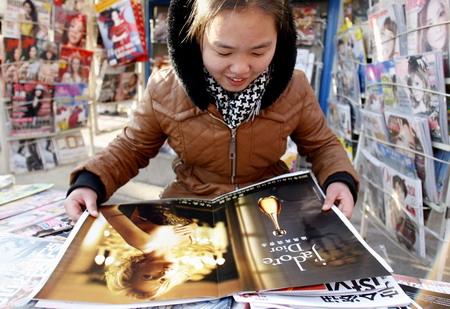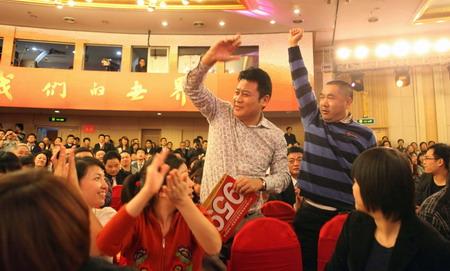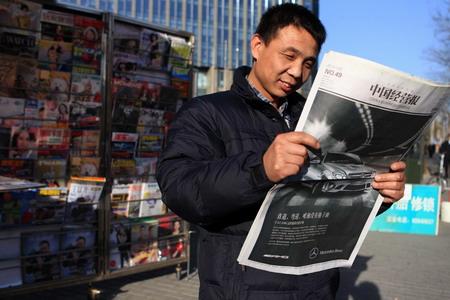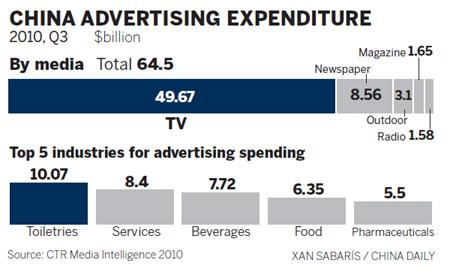
A reader lingers over a newspaper advertisement in Beijing at the weekend. [Photo / China Daily]
Traditional media holding off digital challenge in the Chinese market. Yu Tianyu in Beijing reports.When Mark Twain read his own obituary in 1897, he wrote a letter to his friend assuring him "the report of my death has been exaggerated".
The same could be said for China's traditional media, say analysts.
In contrast to the sector's continued advertising slump in the West, research shows companies targeting Chinese consumers are sticking with television, newspapers and radio. For the time being, anyway.
Total advertising expenditure in the first three quarters of 2010 rose 14 percent on last year to a record-breaking $64.5 billion, according to the latest data from market research firm CTR. Growth was seen across all three traditional sectors.
The old guard are still attracting "international companies due to their enormous influence on local consumers" in big cities, said Yuan Shimin, a top freelance brand consultant based in Beijing.
He explained that the country's "good economic situation and huge consumer spending potential" has largely fueled the boom.
According to the CTR data, spending on television advertising hit $49.67 billion by the end of the third quarter, an increase of 12 percent on 2009.
Newspaper and magazine advertising both saw a 19-percent rise, generating $8.56 billion and $1.65 billion respectively, while radio spots made $1.58 billion, up 33 percent.
Statistics from the State Administration of Radio, Film and Television also show that television and radio stations had seen gains of more than 10 percent as of October, compared to the same period last year.
The full recovery of the Chinese macro economy has "helped create a stable environment for growth in advertising" and robust consumption has "directly strengthened various industries' confidence", explained Barry Cupples, chief executive of Omnicom Media Group's Asia Pacific operations.
Major events at home and abroad have also played a part.
With the World Expo in Shanghai, Asian Games in Guangzhou and soccer's World Cup finals in South Africa all staged this year, an increasing number of companies have used them to "expand their presence, which has had a major influence of branding and marketing", added Yuan.

Two bidders from Wuliangye Group, a large alcohol producer, win six advertisement slots during news shows at China Central Television's annual auction for primetime advertising in Beijing on Nov 8. The total value of winning bids was the highest in 17 years, said the broadcaster. [Photo / China Daily]
Trust in old handsChina Central Television (CCTV), the State broadcaster, held its 17th annual primetime slot auction in November, attracting winning of bids more than 12.67 billion yuan ($1.86 billion), a rise of 15.5 percent year-on-year.
"The amount of money sets a new record in 17 years," said He Haiming, deputy director of the station's advertising and management center, who explained that food and beverage, home appliance and finance and insurance sectors "were the stars".
In a recent report by the New York-based World Brand Lab, CCTV's brand value was put at more than 113.5 billion yuan, putting it fourth domestically behind China Mobile, State Grid and Commercial Bank of China.
Money is rolling in for provincial stations, too. Hunan Satellite TV is expected to make 3.6 billion yuan from advertising this year, thanks largely to its adaptations of shows popular in Britain and the United States, such as American Idol and The Apprentice.
Jiangsu TV, meanwhile, is aiming to generate 1.44 billion yuan in ad revenue, up 200 million on 2009. Following the success of dating show If You Are the One, the broadcaster increased prices by 30 percent.
In the print media, one of the biggest winners has been Shenzhen Press Group, which owns ten newspapers, five journals and a website. The company posted an 8.2-percent year-on-year rise between January and October this year.
An advertising department worker at 21st Century Business Herald, a best-selling financial newspaper owned by Nanfang Daily Media Group, also revealed his office had hit the annual revenue target of 300 million yuan by the end of October.
Beijing News, which has a daily circulation of about 725,000, is also expected to see its advertising income grow by 32 percent year-on-year to 1.4 billion yuan, said president Dai Zigeng.
He explained that most advertisers are in real estate, automobiles, education and tourism, as well as the finance and fashion sectors.
"(Our clients are) usually (promoting) very high-value brands," added Dai. "The high quality and taste of Beijing News is basically dependent on its readership."
According to the 2010 Rich List published by Hurun Report, which monitors China's wealthy, the nation's capital has the highest concentration of millionaires, including 94,000 people with assets worth 100 million yuan or more.
"Whether someone is super rich or not, daily newspapers are still arriving on their breakfast tables or office desks every morning," said consultant Yuan Shimin. "That's the core value of these papers."
Upwardly mobile
Chinese consumers are the most willing to spend their hard-earned cash than anywhere else in the world, according to a recent report by Omnicom Media Group.
According to a company survey, about 45 percent mainlanders say they will spend freely in the next six months, compared to 24 percent in Hong Kong, 18 percent in Singapore and 8 percent in Australia.
The main forces driving consumption in urban areas, say CTR, are "business or high-end" shoppers, as well as the so-called "post-1980s generation".

Businessmen and women generally have more consumption power and influence in their working, social and family circles, "that's why they are so crucial for advertisers", added Sophie Shen, general manager of media and consumption at CTR.
The activities of business leaders mean they cover a wider radius, she said; they read financial newspaper and magazines on flights, they listen to the radio as they drive and they view thousands of advertisements on billboards, on buildings and in restaurants.
Neil Ducray, managing director of Touchmedia, China's largest in-taxi interactive media company, agreed and said that, based on his research, the advertising clients seeing most revenue growth are those targeting the top 20 percent of the population - educated, white-collar workers aged 25 to 44 from households with a monthly income of 5,000 to 10,000 yuan or more.
"As the income (of this group) is going up the most, their expenditures seem to be growing even faster," he said.
Yet, although today's big spenders still turn to traditional media, the next generation of business leaders and officials will likely be more comfortable with the Internet.
"Since most young people spend very few time on traditional media, marketers will have to move to the digital world with their major consumer groups in the future," said Cupples at Omnicom.
Online advertising was worth 9.56 billion yuan in the first half of 2010, up 27.9 percent, according to a report by Nielsen, the global market research firm. The total generated in 2009 was 18 billion yuan.
This year has been an excellent one for Touchmedia, which has seen advertising revenues almost doubling in a number of sectors, including cosmetics, clothing, alcohol, cars and hotels.
So how much of a threat is digital media to the traditional media? Analysts say not much - and suggest that, if integrated well, the two would be better friends than enemies.
"For most (of our clients), the foundations of their media plans are still television or other traditional media, although the shift (toward digital tools) has started," said Ducray.
"Many companies are doubling and even tripling their budgets for digital (and mobile) media marketing for 2011."
The shift overall, however, is likely to be a slow one. After lasting for decades, the traditional media market is not about to be replaced by new media in just a few years, argued Li Kai, vice-president of marketing for VisionChina Media Inc, one of China's largest digital television advertising networks for mass transport systems.
Both new and old have their plus and negative points, making them difficult to compare.
Conventional media offers good market penetration but is weak on awareness, measurability and response. With Internet and mobile marketing, viewers can respond almost instantaneously through their cell phone and computers, but it has a smaller reach.
Newspapers, radio and television also often help drive traffic toward digital media.
"Touchmedia is fortunate to be able to combine the reach of conventional media with the awareness, measurability and response of the Internet or cell phones," said managing director Ducray. "That's been crucial to our success."
Stronger links

A Beijinger reads a newspaper at a news stand last weekend. Newspapers, television and radio organizations - the traditional media - in China still take a large slice of the advertising cake, although the digital media market is growing. Total advertising expenditure rose 14 percent during the first three quarters of 2010, market research shows. [Photo / China Daily]
The central government in July announced a pilot project to merge telecommunications, Internet and broadcast networks in 12 cities, aiming to make the three sectors compatible and allow users to make telephone calls, surf the Web and watch television through one cable or wireless gateway.Experts say the move creates more opportunities for both traditional and new media.
In September, VisionChina also signed a memorandum of understanding with CCTV for a strategic partnership that enables the company to introduce its outdoor mobile television-advertising network to the State broadcaster's client base and to conduct joint promotions during its annual advertising slot auction.
The partnership is expected to provide CCTV's clients with more extensive and comprehensive services by combining their advertising platforms, which will allow both to connect traditional and outdoor television, while broadening audiences.
"We believe VisionChina will start benefiting from the cooperation from 2011," said vice-president Li.
"At present, the advertising market for traditional and new media is not about who will eventually drive out who, but it is to create a comprehensive and diversified win-win model."
The State-owned China National Radio launched its China National Broadcasting Network in August in an effort to enter the digital world, following hot on the heels of CCTV's newly established China Network Television.
"We're delighted to witness the changes happening in advertising for old and new media," said Li.
"New media represents a modern trend in marketing and branding and it will definitely gain more recognition and attention in coming years."






